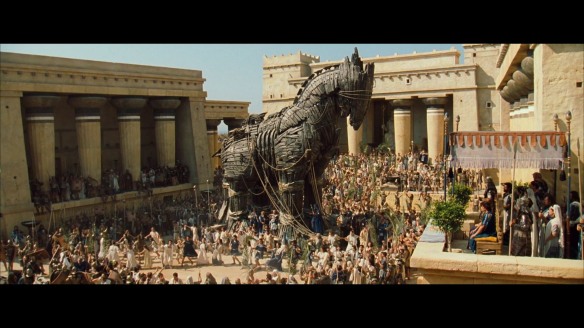Although most scholars agree that the story is fictional, it holds a firm place in Latin and Greek mythology. The main ancient source for the story is the Aeneid, written by the Roman poet Virgil between 29 and 19 BCE. It’s also told in the Odyssey, written by the Greek poet Homer about seven hundred years earlier. While the Trojan Horse might be a myth, the Trojan War does have some basis in historical fact and may have been fought between 1200 and 1100 BCE. Embellished or not, the story of the battles between the forces of Greece and Troy makes for great reading. And the tale of the Trojan Horse is another example of deception in war.
The story goes that the Greeks had encircled the walls of Troy and kept the city in a state of siege for some time. The Greek hero Odysseus could see that in order to break the stalemate and defeat the Trojans, the Greek forces needed a way inside the city’s formidable walls. Odysseus had an idea. He would build a huge wooden horse. But not just any wooden horse. This horse would appear to be a glorious prize of great value, with polished wood and a gilded mane and hooves — a prize the Trojans would surely want to take into their city. And hiding in its belly would be Odysseus and twenty of his most trusted soldiers.
Once the horse had been built, Odysseus and his men climbed inside through a trapdoor. They left their armor behind, for fear that its clanking would give them away. To fulfill their part in Odysseus’s plan, the Greek forces burned their camp and set sail, appearing to have given up on the siege. However, they only sailed far enough to hide behind an island in the Aegean Sea, where they could not be seen from the walls of Troy.
The lure worked. When the Trojans saw the Greek fleet in full sail, they emerged from Troy to verify what the lookouts had told them: that the Greeks had given up and sailed for home. Well, not all the Greeks had departed. A soldier named Sinon had been left behind with a story to tell the Trojan generals. Appearing angry and fearful, he claimed that Odysseus had decided to offer him as a sacrifice to appease the gods. He said that while his guards slept, he had fled and hidden. He explained that the Greeks had built a great wooden horse as an offering to Athena, the goddess of wisdom and military victory. He added that the Greeks had made it so large — too large to be dragged without great effort within the city’s walls — so the Trojans would burn it, thereby bringing the wrath of Athena upon them.
Although the generals listened with interest, Laocoön, a Trojan priest, was not convinced of Sinon’s story and uttered an expression that has been used ever since: “Beware of Greeks bearing gifts.” The story goes that at the moment he voiced his suspicions, two giant serpents glided toward him and his two children, coiled around them all, and crushed the breath out of them. With no one else voicing any misgivings, the Trojans dragged the gigantic horse through the gates into Troy.
The evening was loud with festivities as the Trojans celebrated the departure of the Greeks. In the meantime, Odysseus and his band of warriors waited in the belly of the horse. Soon, the Trojans fell into deep sleep. Sinon crept from Troy and lit a signal fire atop the tomb of Achilles, calling the Greek fleet to return, which it did, as quietly as the night itself. In Troy, a rope ladder dropped from the belly of the horse, and Odysseus and his men climbed out. Two of them opened the gates of Troy, and the Greek troops flooded through.
The battle was long and fierce, but the element of surprise — a product of the Greeks’ deception — had left the Trojans at a disadvantage. For three days, the Greeks plundered the riches of Troy. Some of the Trojans did mount a counterattack, using a deception of their own: putting on the armor of dead Greek soldiers in an attempt to sneak into the enemy’s ranks. But this “false colors” strategy proved futile. Troy was lost. The Greeks had deceived the Trojans with two techniques: the camouflage of the Trojan Horse and the planting of false information in the form of Sinon’s sob story.
